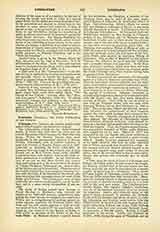

Lismore, School of. —As the School of Armagh in the North of Ireland, and that of Clonmacnoise in the center, so the School of Lismore was the most celebrated in the South of Ireland. It was founded in the year 635 by St. Carthach the Younger, in a most picturesque site, steeply rising from the southern bank of the Blackwater. Its founder had spent nearly forty years of his monastic life in the monastery of Rahan on the southern borders of ancient Meath, in what is now King’s County. He dearly loved that monastery which he had founded, and which he fondly hoped would be the place of his resurrection; but the men of Meath—clerics and chieftains—grew jealous of the great monastery founded in their territory by a stranger from Munster, and they persuaded Prince Blathmac, son of Aedh Slaine, of the southern Hy Niall, to expel the venerable old man from the monastic home which he loved so well. The eviction is described by the Irish annalists as most unjust and cruel, yet, under God‘s guidance, it led to the foundation of Lismore on the beautiful margin of what was then called Avonmore, “the great river”, a site granted to St. Carthach by the prince of the Desii of Waterford. Lismore was founded in 635; and the founder survived only two years, for he died in 637, but Providence blessed his work, and his monastery grew to be the greatest center of learning and piety in all the South of Erin. The “Rule of St. Carthach” is the most, notable literary monument which the founder left behind him. It is fortunately still extant in the ancient Gaelic verse in which it was written. It consists of 135 fourlined stanzas, which have been translated by O’Curry—who has no doubt of its authenticity—and is beyond doubt one of the most interesting and important documents of the early Irish Church.
But Lismore produced a still more famous saint and scholar, the great St. Cathaldus of Tarentum. His Irish name was Cathal, and it appears he was born at a-place called Rathan, not far from Lismore. Our Irish annals tell us nothing of St. Cathaldus, because he went abroad early in life, but the brothers Morini of his adopted home give us many particulars. They tell us he was a native of Hibernia—born at Rathan in Momonia—that he studied at Lismore, and became bishop of his native territory of Rathan, but that afterwards, inspired by the love of missionary enterprise, he made his way to Jerusalem, and on his return was, with his companions, wrecked at Tarentum—the “beautiful Tarentum”—at the heel of Italy. Its pleasure-loving inhabitants, forgetting the Gospel preached to them by St. Peter and St. Mark, had become practically pagans when Cathaldus and his companions were cast upon their shores. Seeing the city given up to vice and sensuality, the Irish prelate preached with great fervor, and wrought many miracles, so that the Tarentines gave up their sinful ways, and from that day to this have recognized the Irish Cathaldus as their patron saint, and greatly venerate his tomb, which was found intact in the old cathedral as far back as the year 1140, with his name “Cathaldus Rathan” inscribed upon a cross therein. Another distinguished scholar of Lismore, and probably its second abbot, was St. Cuanna, most likely the half-brother and successor of the founder. He was born at Kilcoonagh, or Kilccooney, a parish near Headford in the County Galway which takes its name from him. No doubt he went to Lismore on account of his close connection with St. Carthach, and for the same reason was chosen to succeed him in the school of Lismore. Colgan thought that the ancient but now lost “Book of Cuanach”, cited in the “Annals of Ulster”, but not later than A.D. 628, was the work of this St. Cuanna of Kilcooney and Lismore. It is also said that Aldfrid, King of Northumbria, spent some time at the school of Lismore, for he visited most of the famous schools of Erin towards the close of the seventh century, and at that time Lismore was one of the most celebrated. It was a place of pilgrimage also, and many Irish princes gave up the scepter and returned to Lismore to end their lives in prayer and penance. There, too, by his own desire, was interred St. Celsus of Armagh, who died at Ardpatrick, but directed that he should be buried in Lismore—but we have sought in vain for any trace of his monument.
Two interesting memorials of Lismore are fortunately still preserved. The first is the crosier of Lismore, found accidentally in Lismore Castle in the year 1814. The inscription tells us that it was made for Niall Mac Mic Aeducan, Bishop of Lismore, 1090-1113, by Neclan the artist. This refers to the making of the case or shrine, which enclosed an old oak stick, the original crosier of the founder. Most of the ornaments are richly gilt, interspersed with others of silver and niello, and bosses of colored enamels. The second is the “Book of Lismore” found in the castle at the same time with the crosier, enclosed in a wooden box in a builtup doorway. The castle was built so long ago as 1185 by Prince John. Afterwards the bishops of Lismore came to live there, and no doubt both crosier and book belonged to the bishops and were hidden for security in troublesome times. The Book of Lismore contains a very valuable series of the lives of our Irish saints, written in the finest medieval Irish. It was in 1890 admirably translated into English by Dr. Whitley Stokes.
JOHN HEALY

